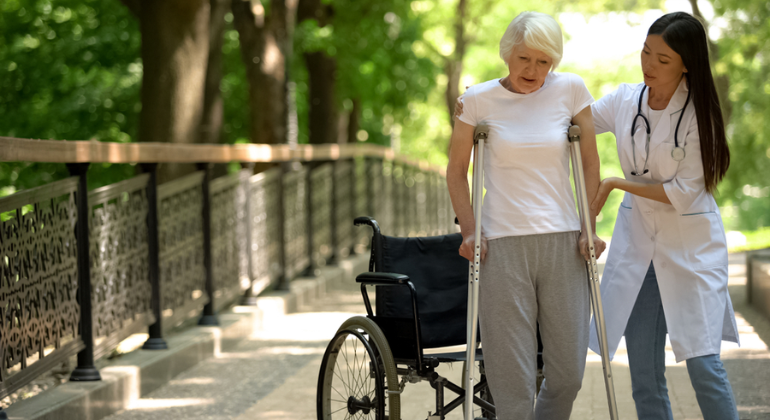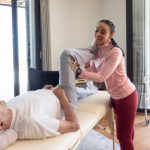Recovering from surgery requires a structured and comprehensive rehabilitation plan to ensure proper healing and the return of normal function. Home physiotherapy for post-surgery recovery has emerged as a preferred choice for patients seeking convenience, personalized care, and better outcomes. In this blog, we’ll explore how home physiotherapy supports post-surgical rehabilitation, how it helps with …
Recovering from surgery requires a structured and comprehensive rehabilitation plan to ensure proper healing and the return of normal function. Home physiotherapy for post-surgery recovery has emerged as a preferred choice for patients seeking convenience, personalized care, and better outcomes.
In this blog, we’ll explore how home physiotherapy supports post-surgical rehabilitation, how it helps with recovery after surgeries like knee replacements, and its effectiveness in managing post-operative stiffness and pain.
Recovering from Knee Replacement: How Home Physiotherapy Can Help

Knee replacement surgery is a significant procedure, and rehabilitation plays a critical role in regaining mobility and reducing discomfort. Opting for home physiotherapy ensures that the recovery process is tailored to your specific needs and progress.
Key Benefits of Home Therapy for Knee Replacement Recovery:

- Personalized Exercise Plans
- Therapists develop customized routines to restore joint flexibility, rebuild muscle strength, and improve walking patterns.
- Exercises such as heel slides, straight leg raises, and gentle stretches help regain motion.
- Pain and Swelling Management
- Manual therapy, ice application, and elevation techniques reduce swelling and post-operative pain.
- Therapists guide patients on how to manage discomfort effectively between sessions.
- Improved Range of Motion
- Stretching and mobilization exercises are introduced to gradually enhance knee flexibility, allowing you to bend and straighten the joint fully.
- Convenient Progress Monitoring
- With in-home sessions, therapists closely track your progress and adjust the treatment plan to prevent complications such as scar tissue buildup.
“Considering home physiotherapy after surgery? A licensed therapist can design a tailored plan to help you regain mobility, manage pain, and recover faster—all from the comfort of your home.”
Home Physiotherapy: A Complete Guide to Post-Surgical Rehabilitation
Post-surgical rehabilitation through home physiotherapy offers a structured, goal-oriented approach to ensure optimal healing. Regardless of the type of surgery, recovery at home focuses on:
1. Restoring Mobility
Surgeries such as hip replacements, ACL repairs, and rotator cuff surgeries can severely limit mobility. Home physiotherapists use exercises and techniques to gradually restore movement while preventing stiffness.
2. Reducing Post-Operative Stiffness and Pain
Post-surgical stiffness and pain are common challenges. Home physiotherapy solutions for post-operative stiffness include:
- Stretching Exercises: Gentle stretches prevent the formation of scar tissue and maintain joint flexibility.
- Soft Tissue Mobilization: Therapists use hands-on techniques to improve circulation and reduce pain.
- Heat or Ice Therapy: Heat relaxes muscles, while ice helps reduce inflammation and pain.
3. Strengthening the Affected Area
Weakness is a natural consequence of surgery and immobility. Therapists guide patients through strengthening exercises to rebuild muscle function and support the surgical site.
4. Preventing Secondary Complications
Inactivity during recovery can lead to complications such as blood clots, muscle atrophy, and poor circulation. Home physiotherapy includes exercises to enhance blood flow, maintain muscle tone, and prevent complications.
Effective Home Physiotherapy Techniques for Post-Operative Stiffness and Pain
Post-operative stiffness and pain can significantly delay recovery if not addressed properly. Home physiotherapy provides a variety of techniques to manage these challenges effectively:
1. Stretching and Range of Motion Exercises
- Therapists introduce movements such as ankle pumps, arm circles, or gentle leg raises to maintain flexibility and prevent stiffness.
- Gradual progression ensures that the exercises remain effective without causing strain.
2. Manual Therapy
- Hands-on techniques like massage and joint mobilization improve circulation, break down adhesions, and reduce muscle tension around the surgical site.
3. Pain Management Techniques
- Incorporating heat, cold, or electrical stimulation therapy alleviates pain and supports the healing process.
- Therapists provide guidance on how to use these modalities safely at home.
4. Core and Support Muscle Strengthening
- For surgeries like spinal fusions or shoulder repairs, strengthening surrounding muscles ensures stability and faster recovery.
Achieving Better Surgery Recovery Outcomes with In-Home Physiotherapy
In-home physiotherapy for surgery recovery outcomes has proven to be highly effective for improving healing and regaining function. Patients benefit from one-on-one attention and customized plans that adapt to their recovery pace.
Advantages of In-Home Physiotherapy:
- Personalized Care in a Familiar Environment
- Being treated at home reduces stress and ensures comfort, especially for patients with limited mobility.
- Therapists can assess and recommend adjustments to the home environment for better support.
- Consistency and Accountability
- Regular home sessions help patients stay consistent with their therapy, leading to quicker and more sustained improvements.
- Reduced Risk of Infection
- For post-surgical patients, avoiding crowded clinics minimizes the risk of exposure to infections, ensuring a safer recovery.
- Faster Recovery with Tailored Programs
- Therapists focus on exercises and techniques specific to the patient’s surgery, ensuring effective rehabilitation.
- For example, after shoulder surgery, treatments include improving shoulder blade mobility and re-establishing shoulder joint function.
Why Home Physiotherapy Is the Right Choice for Post-Surgical Recovery
Choosing home physiotherapy for post-surgery recovery offers unparalleled convenience and effectiveness. Here’s why it’s the preferred choice for many patients:
- Tailored to Individual Needs: Each program is designed to address the unique challenges of your surgery, whether it’s pain, stiffness, or limited mobility.
- Convenient and Time-Saving: Eliminates the need for travel, which is especially important during the early stages of recovery when movement may be difficult.
- Comprehensive Care: Therapists don’t just focus on exercises; they provide education on posture, ergonomics, and techniques to prevent complications.
Conclusion
Home physiotherapy for post-surgery recovery is an effective, personalized, and convenient way to regain mobility, reduce pain, and achieve optimal outcomes after surgery. Whether it’s rehabilitation for knee replacement, hip surgery, or rotator cuff repair, home-based care ensures that your recovery plan aligns with your specific needs.
With the added benefits of post-surgical rehabilitation through home physiotherapy, such as reduced stiffness, pain management, and improved strength, you can experience a faster and safer recovery—all from the comfort of your home. Take the first step toward better healing by consulting a licensed physiotherapist and exploring the possibilities of in-home care.
Recover from knee surgery and other procedures with personalized home physiotherapy. Painflame brings expert post-surgical care to your home in Gurgaon. Book now!
Recent Blog : How Does Home Physiotherapy Work for Back Pain?
Frequently Asked Questions (FAQs)
What are the benefits of home physiotherapy for post-surgery recovery?
Home physiotherapy offers personalized care to manage pain, reduce stiffness, and restore mobility after surgery. Whether it’s a knee replacement, hip surgery, or spinal procedure, this approach ensures tailored exercises, convenience, and faster recovery—all from the comfort of your home.
How soon can I start home physiotherapy after knee or other surgeries?
For most surgeries, including knee replacements, home physiotherapy can start within 2–7 days post-operation. Early sessions focus on gentle movements and pain management to prevent stiffness and complications. Always consult your doctor and physiotherapist for the right timing.
What equipment is needed for home physiotherapy for post-surgery recovery?
Essential tools include a yoga mat, resistance bands, and a sturdy chair. For knee or hip surgeries, therapy balls, foam rollers, and ankle weights may also be used. Your physiotherapist will customize the equipment based on your surgery and recovery needs.
How does home physiotherapy help with post-operative pain management?
Home physiotherapy includes pain relief techniques such as manual therapy, stretching, and heat or cold therapy. For surgeries like knee replacement, targeted exercises strengthen muscles and improve circulation, reducing inflammation and discomfort.
Can home physiotherapy prevent long-term complications after surger
Yes, home physiotherapy helps prevent complications like blood clots, joint stiffness, or muscle weakness. For example, after knee surgery, it improves mobility and strengthens surrounding muscles, ensuring a smoother recovery and better long-term outcomes.






